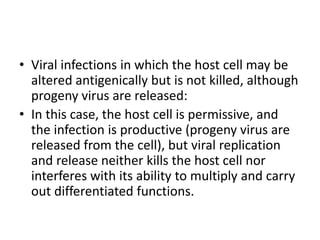This document discusses viral replication. It begins by defining viruses and their basic components. Viruses replicate through an intracellular process that involves attaching to and entering a host cell, uncoating their genome, expressing genes, replicating their genome, assembling new virions, and exiting the host cell. The replication process varies between virus families but generally follows these basic steps. Viruses are classified based on characteristics like their nucleic acid, replication strategy, and presence of an envelope.





















![• In both cases, multiple copies of these
molecular attachment structures are
distributed around the surface of the virion.
[Note: In some cases, the mechanism by
which antibodies neutralize viral infectivity is
through antibody binding to the viral
structures that are required for adsorption
(Figure 23.8B).]](https://image.slidesharecdn.com/viralreplication1-160511124326/85/Viral-replication-1-22-320.jpg)































































